Publications
Publications
Lessons Learned
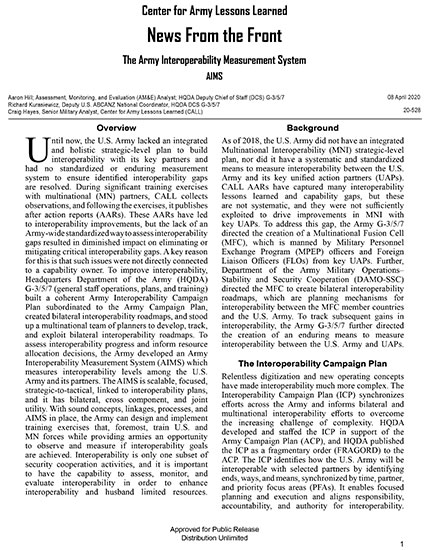 NFTF: The Army Interoperability Measurement System - AIMS
NFTF: The Army Interoperability Measurement System - AIMS
To assess interoperability progress and inform resource allocation decisions, the Army developed an Army Interoperability Measurement System (AIMS) which measures interoperability levels among the U.S. Army and its partners. The AIMS is scalable, focused, strategic-to-tactical, linked to interoperability plans, and it has bilateral, cross component, and joint utility. With sound concepts, linkages, processes, and AIMS in place, the Army can design and implement training exercises that, foremost, train U.S. and MN forces while providing armies an opportunity to observe and measure if interoperability goals are achieved.
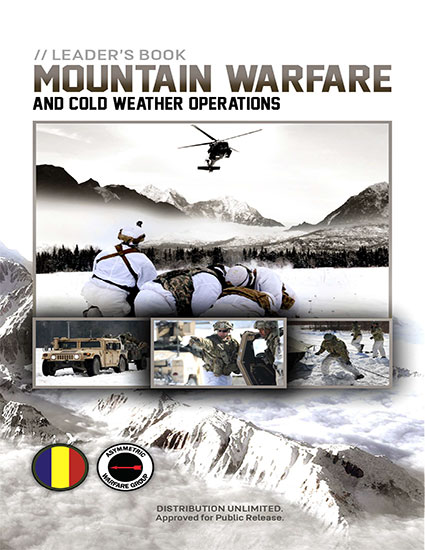 Mountain Warfare and Cold Weather Operations Leader's Book
Mountain Warfare and Cold Weather Operations Leader's Book
Mountains present leaders and units with unique challenges that compound existing difficult combat realities. This handbook addresses the principal gap of informing leaders and staff of the considerations necessary to plan, operate, fight, and win in mountainous terrain at the company level and above. Leaders will find this handbook valuable in prioritizing tasks for training and predeployment planning for any military operations in the mountains.
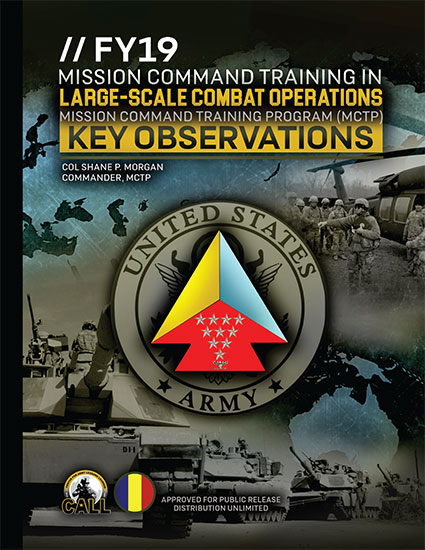 FY19 Mission Command Training in Large-Scale Combat Operations MCTP Key Observations
FY19 Mission Command Training in Large-Scale Combat Operations MCTP Key Observations
Mission Command Training Program trains Army functional/multi-functional/maneuver brigades, divisions, expeditionary sustainment commands, Corps, special operations units, and U.S. Air Force personnel in mission command and large-scale combat operations. This publication provides an overview of the top seven collective trends organized by echelon of command and warfighting function, with additional emphasis on the integration of U.S. Air Force assets, special operations forces, and cyberspace electromagnetic activities. NCO utilization observations are also included to help facilitate the integration of NCOs into command posts. The goal is to increase the readiness of units to plan, prepare, fight, and win in any environment. Winning matters!
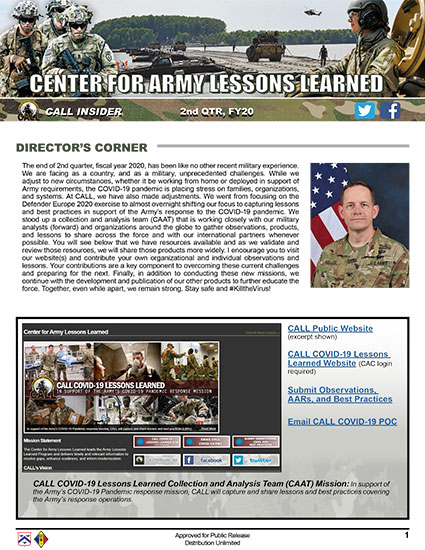 CALL Insider Newsletter, 2nd Qtr, FY20
CALL Insider Newsletter, 2nd Qtr, FY20
This quarter we have shifted focus to the Army's COVID-19 pandemic response
efforts. We have resources available, and as we validate and review those
resources, we will share those products more widely. We also encourage our
readers to submit observations, lessons, and best practices to us via our
public website. Unit and individual contributions are a key component to
overcoming these current challenges and preparing for the next.
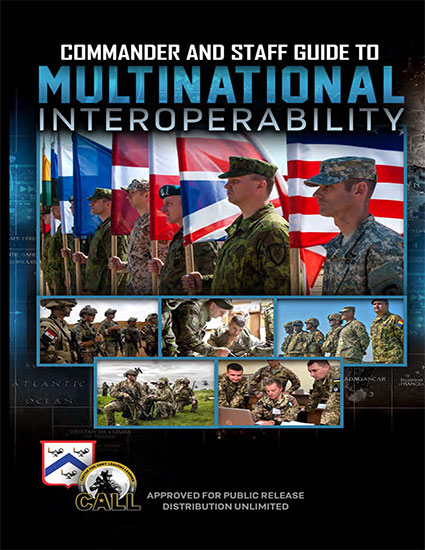 20-12: Commander and Staff Guide to Multinational Interoperability
20-12: Commander and Staff Guide to Multinational Interoperability
This guide addresses three key areas to improved multinational interoperability: introducing a common understanding of interoperability; exploring a framework encompassing the human, procedural, and technical domain solutions to improved interoperability; and showing how leaders can integrate "planning for interoperability" within the operations process.
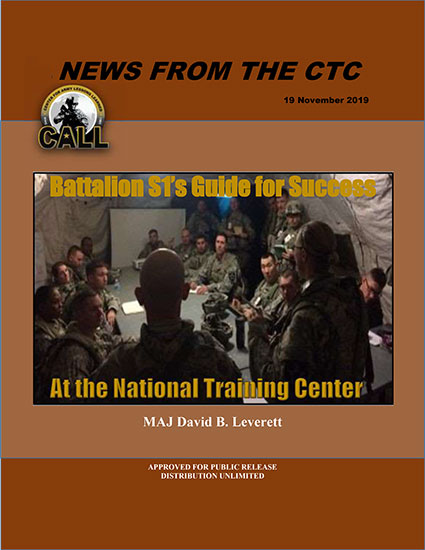 News From the CTC - BN S1’s Guide for Success at the National Training Center
News From the CTC - BN S1’s Guide for Success at the National Training Center
This article is for all S1s conducting home station training to prepare themselves for a combat training center rotation and combat. Generally, the battalion S1 understands his or her duties and responsibilities in a garrison environment. However, it is often a different story in a field environment where the S1 can be uncomfortable and unsure of the field duties and expectations from his or her command, especially with someone new to the position. This article breaks down the essential S1 functions in a field environment: personnel accountability, strength reporting, casualty reporting, personnel reconstitution, and planning.
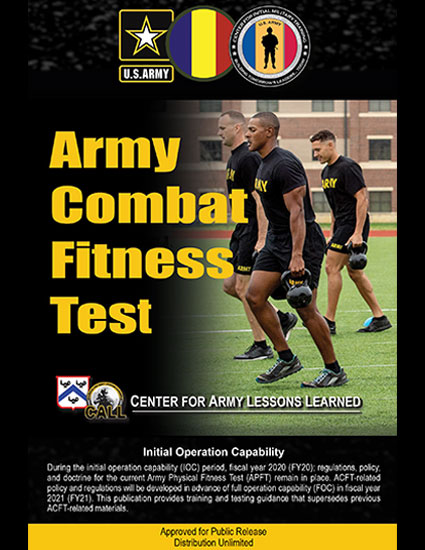 20-09 - Army Combat Fitness Test (Version 2)
20-09 - Army Combat Fitness Test (Version 2)
The Army Combat Fitness Test is the means to validate a Soldier and unit’s physical readiness training; it shows how effective this training is in preparing Soldiers for the combat tasks they have to perform. This publication supplements the Army’s physical testing doctrine for the initial operation capability period, Fiscal Year 20, 01 October 2019 to 30 September 2020. The principal audience is leaders at all organizational levels.
 20-06: How to Master Wargaming
20-06: How to Master Wargaming
This handbook focuses on three items: First, how to improve and develop the cognitive skill of visualizing, a key component to COA analysis (wargaming); second, improving the methods and conduct of action, reaction, and counteraction adjudication of COA analysis with off-the-shelf wargames; and third, thoughts on training the staff. COA analysis is similar to any collective skill, and is perishable if not continually trained and rehearsed. Therefore, it is the purpose of this handbook to provide thoughts on how to develop individuals and staffs so they can better conduct COA analysis during the military decisionmaking process.
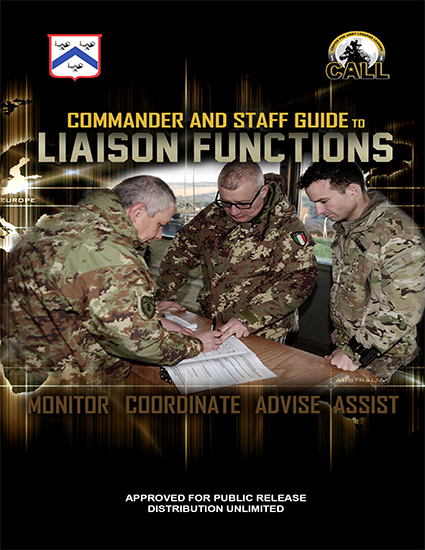 20-05 - Commander and Staff Guide to Liaison Functions
20-05 - Commander and Staff Guide to Liaison Functions
Liaison officer (LNO) functions are critical to the successful integration of diverse capabilities across military and civilian domains. Despite the importance of these functions, the Center for Army Lessons Learned continues to capture observations which indicate significant issues concerning the selection, training, and employment of LNOs. This Handbook is designed to provide planning and execution guidance for the employment of LNOs in a single source document.
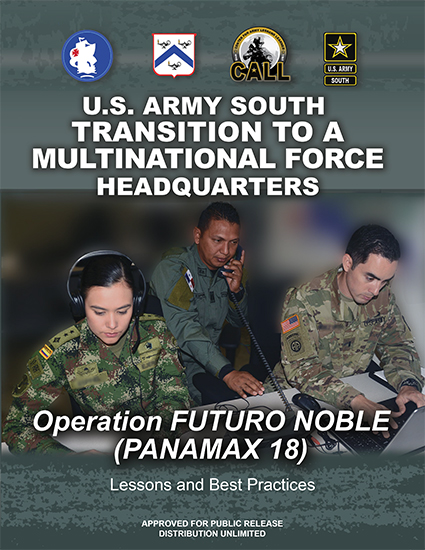 20-02 - U.S. Army South Transition to a Multinational Force Headquarters (PANAMAX 18)
20-02 - U.S. Army South Transition to a Multinational Force Headquarters (PANAMAX 18)
Operation FUTURO NOBLE (PANAMAX 2018) is a U.S. Southern Command-sponsored, combatant commander exercise. The exercise scenario focused on a multinational response under a United Nations Security Council resolution to counter security threats to the Panama Canal and surrounding region. This book also addresses the transition of U.S. Army South to a combined joint task force headquarters named Multinational Force South.
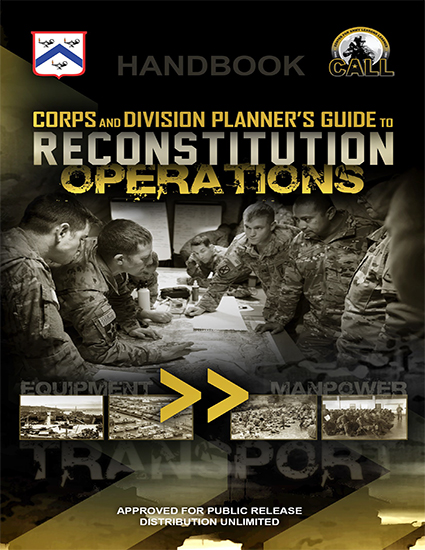 20-01 - Corps and Division Planner’s Guide to Reconstitution Operations
20-01 - Corps and Division Planner’s Guide to Reconstitution Operations
This handbook serves as an aid to corps- and division-level staffs as they plan and prepare to conduct reconstitution operations. It provides insights into challenges the staff will face when planning reconstitution operations, outlines responsibilities of key individuals throughout the process, and finally provides planning considerations to facilitate an all-encompassing reconstitution plan.
The Joint Readiness Training Center (JRTC) turned to decisive action training with what was called, at the time, a full spectrum operations (FSO) rotation in October 2010. The shift to a decisive action training environment (DATE) did not lessen the challenges of FSO; it merely placed them inside DATE as a more accurate depiction of unified land operations.
Regardless of rotational design (FSO versus DATE), company-level leaders find decisive action a challenge for themselves, their Soldiers, and their units. As the opposition force (OPFOR) in the DATE, 1st Battalion, 509th Parachute Infantry Regiment (Geronimo) made the DATE rotation at the JRTC a “school of hard knocks.” For those company-level leaders, a JRTC DATE rotation was combined arms maneuver (CAM) centric.
This newsletter is about company-level CAM, concentrating on basics for company leaders and their units. When reading it, think home-station training. Units that get after the basics discussed here during home-station training fare better against Geronimo. Those that do not will prove themselves a meal ready-to-eat for the Geronimo personnel.
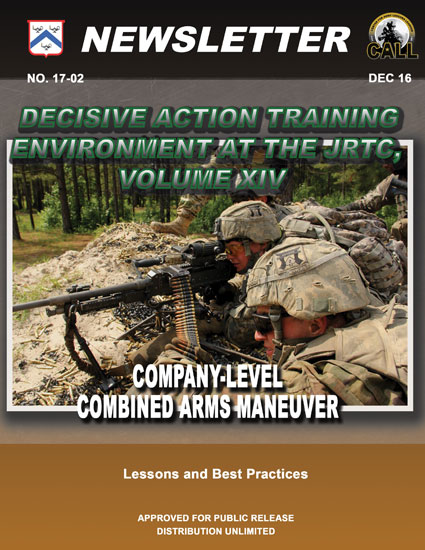 17-02: DATE at the JRTC, Volume XIV
17-02: DATE at the JRTC, Volume XIV
Pages
Handbooks
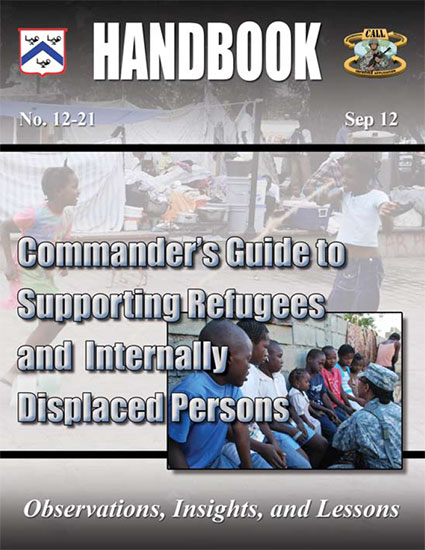 12-21 Commander's Guide to Supporting Refugees and Internally Displaced Persons Handbook
12-21 Commander's Guide to Supporting Refugees and Internally Displaced Persons Handbook
This CALL Handbook is a compilation of ILE student papers from the DLRO course "Refugees and Displaced Persons in the Operational Environment."
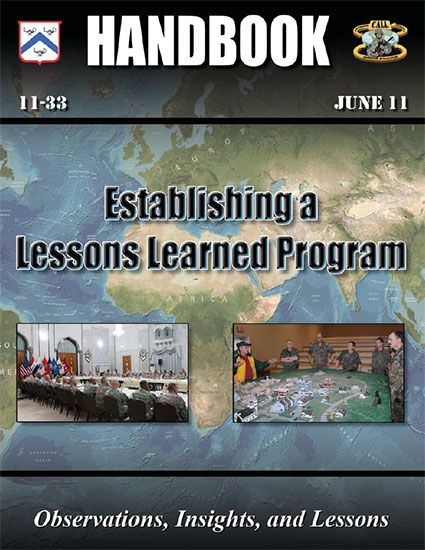 11-33 - Establishing a Lessons Learned Program
11-33 - Establishing a Lessons Learned Program
For many years, the U.S. Army recognized the need to share information or lessons gained from training and actual combat operations. During World War II and the Korean War, the Army published "combat bulletins" in an attempt to share combat experiences with other Soldiers. During the Vietnam War, Army units published quarterly operational reports that made an effort to share lessons from combat operations. By doing this, units learned from the mistakes others made and were given an opportunity to avoid the same problems.
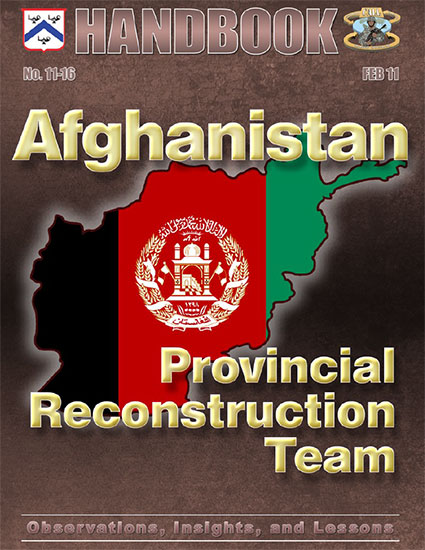 11-16 - Afghanistan Provincial Reconstruction Team Handbook
11-16 - Afghanistan Provincial Reconstruction Team Handbook
This handbook is a guide to the Provincial Reconstruction Team (PRT) in Afghanistan. It contains part of the ISAF PRT Handbook as well as background information on each of the Provinces. There is also a chapter on the Tactical Conflict Assessment and Planning Framework currently used in Afghanistan.
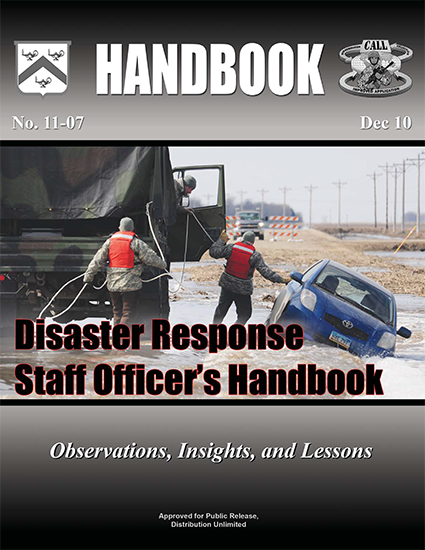 11-07 Disaster Response Staff Officer's Handbook
11-07 Disaster Response Staff Officer's Handbook
Defense support to civil authorities (DSCA) within the U.S. is not a new mission for the military. Despite this, CALL collection and analysis teams (CAAT) routinely reveal observations that tactical units do not understand the restraints or constraints of the body of statutes, regulations, and presidential orders pertaining to responding to disasters and incidents at home.
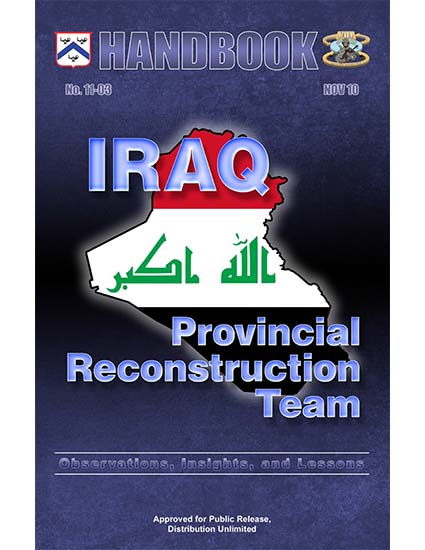 11-03 Iraq Provincial Reconstruction Team Handbook
11-03 Iraq Provincial Reconstruction Team Handbook
This handbook is a country specific guide for Provincial Reconstruction Teams in Iraq in the post surge environment.
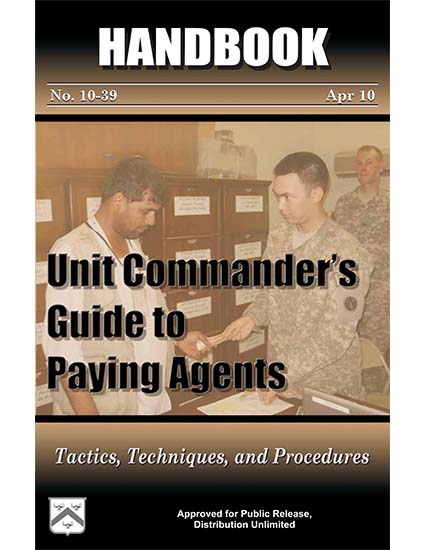 10-39 Unit Commander’s Guide to Paying Agents Handbook
10-39 Unit Commander’s Guide to Paying Agents Handbook
The United States Army Financial Management School (FMS) and the Center for Army Lessons Learned (CALL) partnered to produce a “how to” guide to assist unit commanders, their paying agents (PAs), and their field ordering officers (FOOs) meet their responsibilities in regard to paying for support to accomplish their unit’s missions. This handbook provides deployed unit commanders, their PAs, and their FOOs a reference guide on the procedures for obtaining funds and clearing funds.
 10-19 Small-Unit Leaders Guide to the Command Supply Discipline
10-19 Small-Unit Leaders Guide to the Command Supply Discipline
The Command Supply Discipline Program (CSDP) is a commander's program. This handbook addresses the CSDP every unit must establish and enforce.
 10-10 - Agribusiness Development Teams (ADT) in Afghanistan Handbook
10-10 - Agribusiness Development Teams (ADT) in Afghanistan Handbook
Agriculture accounts for 45 percent of Afghanistan's gross domestic product and is the main source of income for the Afghan economy. Over 80 percent of the Afghan population is involved in farming, herding, or both. However, decades of war, drought, and security challenges have devastated the country's agricultural sector, and the current level of U.S. government civilian support has been unable to keep pace with the tremendous need for assistance in this region. Revitalizing Afghanistan's agricultural sector is critical to building the government's capacity and to stabilizing the country.
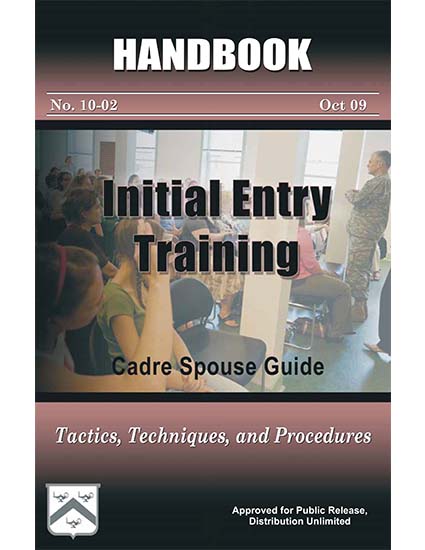 10-02 Entry Training Spouses Handbook
10-02 Entry Training Spouses Handbook
This handbook is intended to help new Initial Entry Training cadre spouses get oriented to their Soldier's new assignment, the new responsibilities of their cadre member, and to provide advice on preparing for the IET environment.
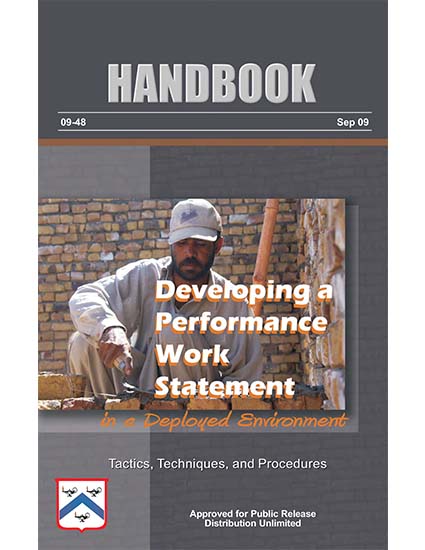 09-48 Developing a Performance Work Statment in a Deployed Environment Handbook
09-48 Developing a Performance Work Statment in a Deployed Environment Handbook
This handbook contains a summary of how to write a Performance Work Statement (PWS), an action frequently required of Contingency Contracting Officers when deployed. Army reliance on contracts for equipment, supplies, and services has significantly increased in recent years. Most contracts are not huge multi-million dollar programs, but instead generally small "micro purchases" used by units to meet one time, immediate needs. This handbook serves as a ready reference to assist in writing clear, simple, concise, and legally enforceable PWS.
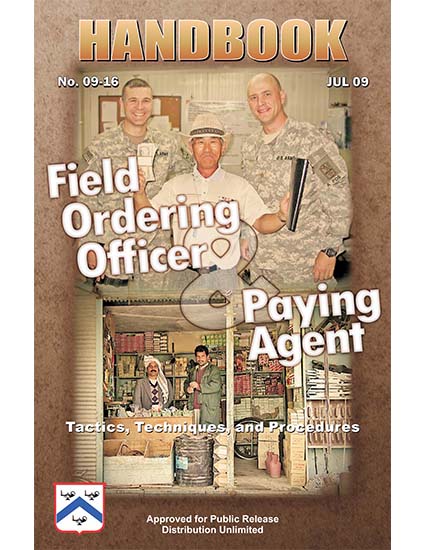 09-16 The Battlefield Field Ordering Officer & Pay Agent Handbook
09-16 The Battlefield Field Ordering Officer & Pay Agent Handbook
This first edition of the Battlefield Field Ordering Officer and Paying Agent Handbook contains a summary of acquisition policies, procedures, and managerial skills field ordering officers (FOOs)* and paying agents frequently require in deployed environments. FOOs and paying agents operating in deployed environments face realities not found in operations in the continental United States.
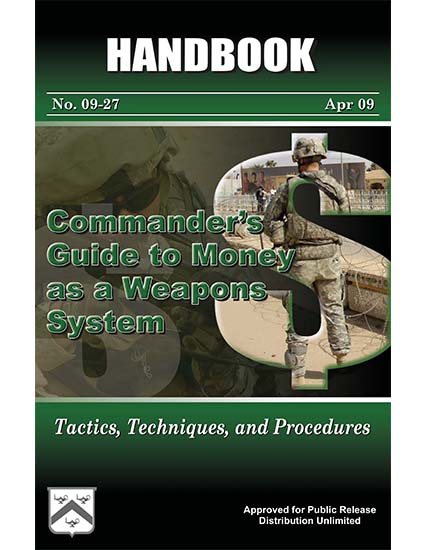 09-27 Commander's Guide to Money as a Weapons System Handbook
09-27 Commander's Guide to Money as a Weapons System Handbook
This handbook assists company-, battalion-, and brigade-level officers and noncommissioned officers to effectively use money as a weapons system on the counterinsurgency (COIN) battlefield. Coalition money is defeating COIN targets without creating collateral damage, by motivating antigovernment forces to cease lethal and nonlethal operations, by creating and providing jobs along with other forms of financial assistance to the indigenous population, and by restoring or creating vital infrastructure.
Pages
Newsletters
 Newsletter 16-30: DATE at the NTC Vol. IV
Newsletter 16-30: DATE at the NTC Vol. IV
This volume is the fourth installment of the NTC decisive action series published by the Center for Army Lessons Learned. It represents our commitment to the ongoing professional discussion of how the Army, as the component responsible for imposing the will of the Nation upon our enemies, achieves decisive action by means of our core competencies.
 16-27: Pacific Pathways Lessons and Best Practices Newsletter
16-27: Pacific Pathways Lessons and Best Practices Newsletter
This newsletter is the final document of a series consisting of three initial impression reports (IIRs) documenting Pacific Pathways 15.
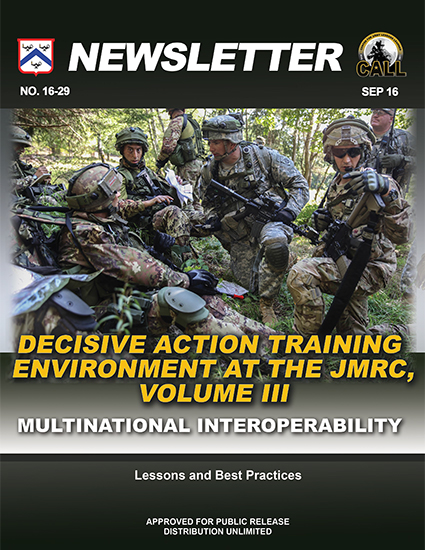 16-29 - DATE at the JMRC Vol. III: Multinational Interoperability Newsletter
16-29 - DATE at the JMRC Vol. III: Multinational Interoperability Newsletter
The tactical lessons in multinational interoperability contained in this newsletter are not unique to the NATO alliance but are, however, transcendent to any situation in which a military coalition of nations must form, build a cohesive team, and operate seamlessly against a common enemy at the tactical level of warfare. This newsletter's collection of articles is intended to supplement and reinforce those lessons described in our publication of the Multinational Interoperability Reference Guide (CALL Handbook 16-18). Thus, the goal is to provide tactical-level insights and lessons gleaned from numerous multinational exercises that military leaders can use to logically approach the complexities of interoperability in multinational environments.
 16-24: DATE at the JRTC, Volume XIII Newsletter
16-24: DATE at the JRTC, Volume XIII Newsletter
This newsletter looks at the manner, method, objectives, and results of collective training for warfare in the 21st century. It addresses ways to achieve unity of effort on a complex battlefield with numerous players, each with their own mission. Unity of effort is of paramount importance for success. It requires direct attention by the senior Army commander to move disparate organizations not under his control in the same direction to achieve complementary results to
a common objective. A quote within this publication effectively describes this, "There was a shared vision of a solution to the challenges ahead, there was a common understanding of counterpart priorities and, most importantly, there was a trust and respect for one another that had grown."
 CALL Insider Newsletter Mar-Apr 2016
CALL Insider Newsletter Mar-Apr 2016
Welcome to the March/April 2016 edition of the CALL Insider Newsletter. During the past two months, CALL analysts participated in multiple collections and training events including U.S. Army Central’s (USARCENT) Lucky Warrior 16 exercise and the Mission Command Training Program’s (MCTP) warfighter (WfX) 16-4 exercise collection. This edition highlights CALL’s support to the Joint Multinational Training Group-Ukraine (JMTG-U) and to the institutional Army in various educational settings. We are also pleased to feature the newly signed Army Regulation (AR) 11-33, which codifies the Army’s and commanders’ roles in the Army Lessons Learned Program (ALLP).
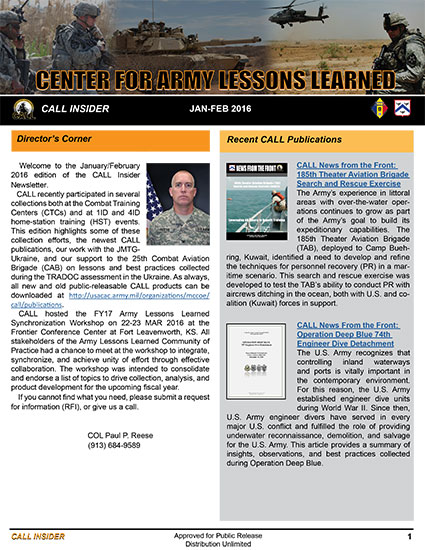 CALL Insider Newsletter Jan-Feb 2016
CALL Insider Newsletter Jan-Feb 2016
Welcome to the January/February 2016 edition of the CALL Insider Newsletter. CALL recently participated in several collections both at the Combat Training Centers (CTCs) and at 1ID and 4ID home-station training (HST) events. This edition highlights some of these collection efforts, the newest CALL publications, our work with the JMTG Ukraine, and our support to the 25th Combat Aviation Brigade (CAB) on lessons and best practices collected during the TRADOC assessment in the Ukraine.
 16-08: Decisive Action Training Environment at the JRTC, Volume XI
16-08: Decisive Action Training Environment at the JRTC, Volume XI
The shift to a decisive action training environment (DATE) challenges the sustainment warfighting function (WfF) in a manner that few sustainers have seen before. “Fighting a moving fight instead of fighting the move” describes the challenge a DATE presents to the movement and maneuver and mission command WfFs. For the sustainment WfF, this challenge becomes “sustaining the moving fight while moving the sustainment capacity.” This newsletter examines that challenge in detail. We hope the information in this newsletter will provide you with the realization that DATE sustainment means the sustainer must be three mental steps ahead of the maneuver leader to successfully support a DATE operation.
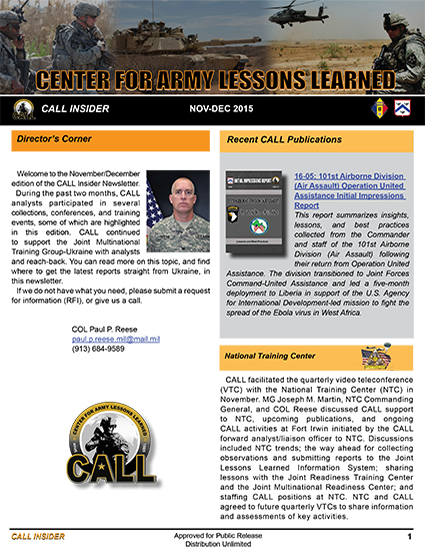 CALL Insider Newsletter Nov-Dec 2015
CALL Insider Newsletter Nov-Dec 2015
Welcome to the November/December edition of the CALL Insider Newsletter. During the past two months, CALL analysts participated in several collections, conferences, and training events, some of which are highlighted in this edition. CALL continued to support the Joint Multinational Training Group-Ukraine with analysts and reach-back. You can read more on this topic, and find where to get the latest reports straight from Ukraine, in this newsletter.
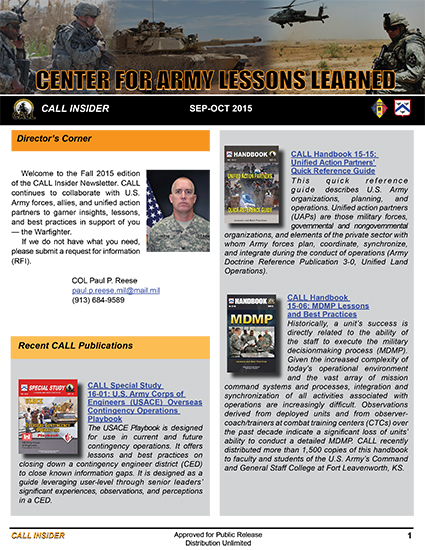 CALL Insider Newsletter Sep - Oct 2015
CALL Insider Newsletter Sep - Oct 2015
Welcome to the Fall 2015 edition of the CALL Insider Newsletter. CALL continues to collaborate with U.S. Army forces, allies, and unified action partners to garner insights, lessons, and best practices in support of you the Warfighter.
The new logo reflects CALL’s 30 years of service in support of the warfighter. CALL
was established on 01 AUG 1985 by the 30th Chief of Staff of the Army, GEN John
A. Wickham Jr., in recognition of the need to collect lessons from training and combat
operations and to share them across the Army.
In the beginning years of our existence, CALL primarily collected and produced analog
(paper) products related to home station training and unit rotations featuring force-on-force
engagements at the maneuver Combat Training Centers. It was not long thereafter that
we proved our mettle in combat operations, as CALL supported Operation Just Cause in
1989 and Operations Desert Shield and Desert Storm in the early 1990s. As technology evolved, so did CALL.
In the early portion of the 2000 decade, CALL established public, NIPR, and SIPR websites, posting digital
products, while continuing to push paper products to the field. We have continued to identify, collect, analyze,
disseminate, and archive lessons and best practices from Operations Iraqi Freedom and Enduring Freedom in
the past decade-plus and for numerous other operations, including peacekeeping efforts in Bosnia-Herzegovina
and humanitarian assistance at home (i.e., Hurricane Katrina) and around the globe (i.e., Operation United
Assistance to combat the Ebola virus).
Many things have changed in the past three decades, but one item has remained constant: It is this organization’s
dedication to support troops, leaders, and units to help maintain global situational awareness in order
to share knowledge and facilitate the Army’s and unified action partners’ adaptation to win wars — now, Force
2025, and beyond.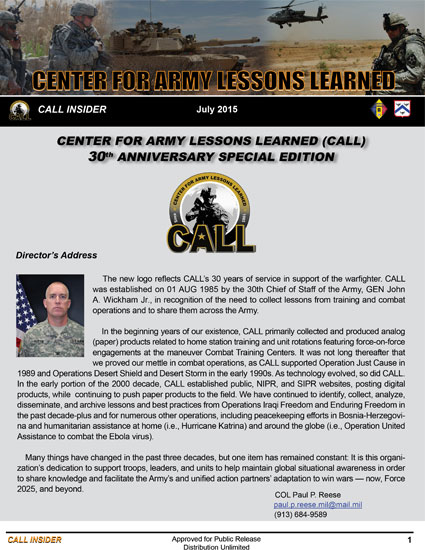 CALL Insider 30th Anniversary Special Edition Newsletter
CALL Insider 30th Anniversary Special Edition Newsletter
On 01 AUG 2015, CALL celebrated its 30th anniversary of providing lessons and best practices to the U.S. Army and our unified action partners.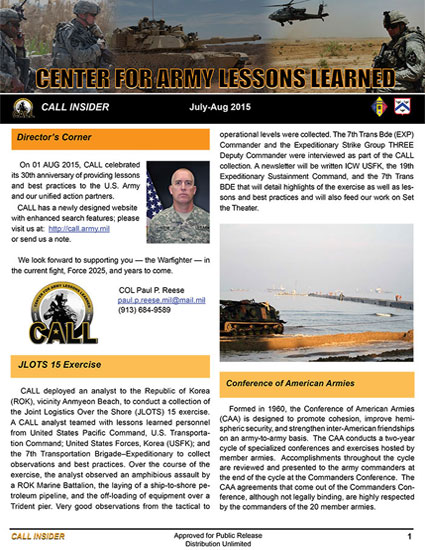 CALL Insider Newsletter July-Aug 2015
CALL Insider Newsletter July-Aug 2015
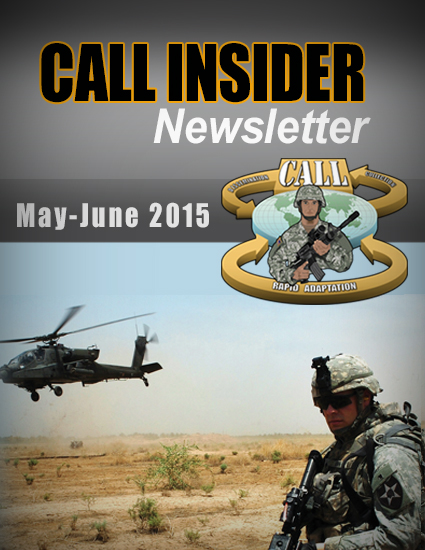 CALL Insider Newsletter May-June 2015
CALL Insider Newsletter May-June 2015
CALL Insider Newsletter May-June 2015
Pages
News from the Front
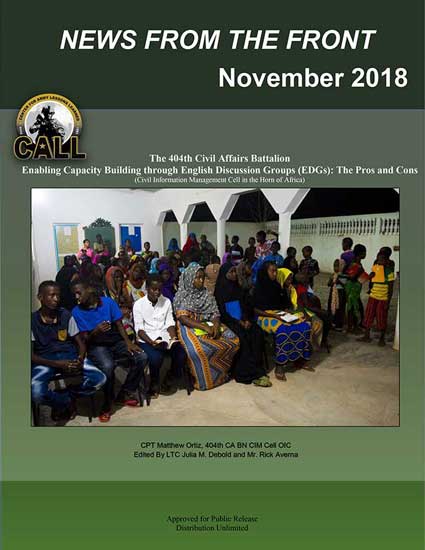 News From the Front - The 404th Civil Affairs Battalion: Enabling Capacity Building Through English Discussion Groups (EDGs): The Pros and Cons
News From the Front - The 404th Civil Affairs Battalion: Enabling Capacity Building Through English Discussion Groups (EDGs): The Pros and Cons
English Discussion Groups (EDGs) have been an enduring mission of the Civil Affairs Battalion (CA BN) in Djibouti since 2007. EDGs are not new to the Army and are considered a component of capacity building, but this type of mission has not been addressed in civil affairs doctrine since the late sixties. It has, however, reemerged as a priority line of effort for the CA BN deployed to Combined Joint Task Force-Horn of Africa in Djibouti. This document describes the various EDGs currently in operation in Djibouti and is meant to summarize the strengths and weaknesses of this as an enabling activity in the region. The information is presented from the perspective of the Civil Information Management Cell officer-in-charge.
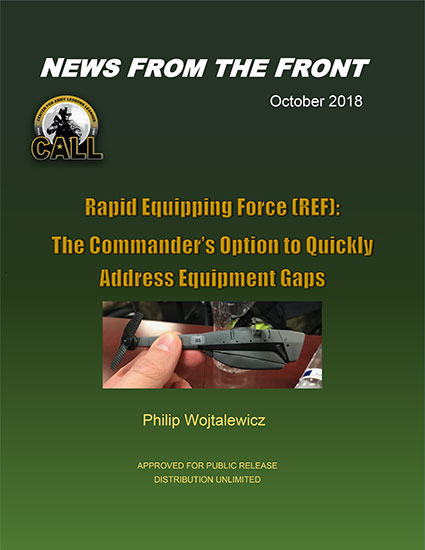 NFTF - Rapid Equipping Force: The Commander's Option to Quickly Address Equipment Gaps
NFTF - Rapid Equipping Force: The Commander's Option to Quickly Address Equipment Gaps
When there is an equipment (hardware, software, weapon, tool, etc.) capability gap, what solutions does a unit have at its fingertips? The United States Army provides units with two means to solve the issue: the Operational Needs Statement (ONS) and the Rapid Equipping Force (REF) 10-Liner Request for Capability. If the need is urgent, the REF 10-Liner is the way to go. The purpose of this article is to explain the REF 10-Liner and detail the very easy-to-complete form in order to help Soldiers and leaders.
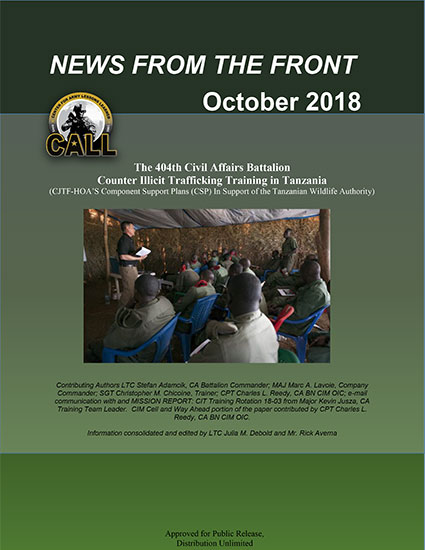 NFTF - The 404th Civil Affairs Battalion, Counter Illicit Trafficking Training in Tanzania
NFTF - The 404th Civil Affairs Battalion, Counter Illicit Trafficking Training in Tanzania
One of the missions of the 404th Civil Affairs Battalion (CA BN) of the Combined Joint Task Force-Horn of Africa (CJTF-HOA) is to conduct counter illicit trafficking (CIT) training in Tanzania; it is one of the unit's enduring and perhaps more interesting missions in Africa. Aside from the pure training aspect, the mission demonstrates suitable nesting with the lines of effort of the CJTF-HOA campaign support plan, the benefits of multiagency contribution, specific properties associated with greater success in building partner capabilities/capacity and finally the importance of using the CA BN's civil information management cell to analyze information for situational awareness and to establish an assessments program to evaluate effectiveness in order to modify courses of action as needed.
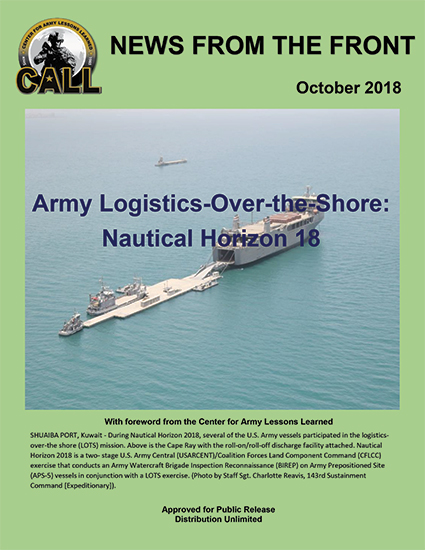 NFTF - Army Logistics-Over-the-Shore: Nautical Horizon 18
NFTF - Army Logistics-Over-the-Shore: Nautical Horizon 18
The purpose of this NFTF is to highlight the complexities involved with logistics-over-the-shore. It is presented in two parts: one an overview from CALL analysts stationed forward in the AOR and another excerpted from a SUSTAINER article.
 NFTF - Class VIII Blood Supply Support to Current Operations for Medical Planners
NFTF - Class VIII Blood Supply Support to Current Operations for Medical Planners
This article discusses the challenges of providing class VIII blood and blood products to austere theaters of operation. In many of the austere locations the Army operates in, countries do not meet the medical standard that the U.S. requires. Therefore, perishable Class VIII items must be supplied and sustained in theater from the U.S. or U.S. approved stores such as the Armed Services Blood Bank Center - Europe (ASBBC-E). While this article focuses on the Horn of Africa (CJTF-HOA), the insights and information provided are pertinent to all theaters and should interest medical service corps planners across the Army.
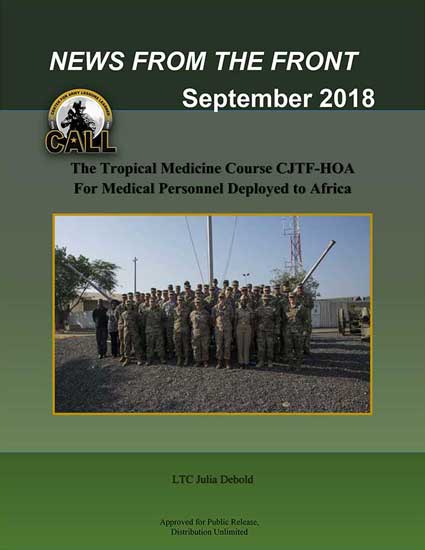 NFTF: The Tropical Medicine Course CJTF-HOA for Medical Personnel Deployed to Africa
NFTF: The Tropical Medicine Course CJTF-HOA for Medical Personnel Deployed to Africa
The endstate of the Military Tropic Medicine (MTM) Course is to increase force health protection (FHP) and troop readiness, just as FHP was a primary endstate for Britain and U.S. interests with regard to tropical diseases more than a century ago. A more immediate objective in achieving the endstate is to provide medical personnel with relevant knowledge and understanding to address medical issues specific to deployment areas, especially for those who may be a considerable distance from a military base.
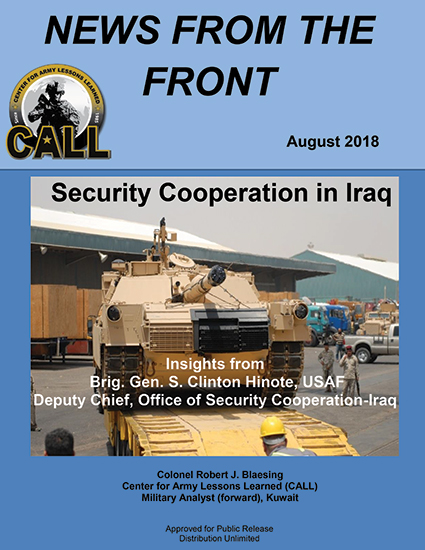 NFTF: Insights from Brig. Gen. S. Clinton Hinote, USAF Deputy Chief, Office of Security Cooperation-Iraq
NFTF: Insights from Brig. Gen. S. Clinton Hinote, USAF Deputy Chief, Office of Security Cooperation-Iraq
This article summarizes the key points from an end of tour interview with Brigadier General S. Clinton Hinote, USAF, Deputy Chief for the Office of Security Cooperation-Iraq from February 2017 to February 2018 and includes a white paper written by the general entitled “Iraq What Now? Consolidating Coalition Gains with Smart, Limited Investments.”
 NFTF - Advising at the Ministerial Level in Afghanistan: Insights from Major General Willard M. Burleson III
NFTF - Advising at the Ministerial Level in Afghanistan: Insights from Major General Willard M. Burleson III
CALL's Strategic Analysis Branch conducted an interview on 9 July 2018, with MG Burleson, 7th Infantry Division Commander, to collect insights into his activities while he was serving as the Senior Advisor to the Ministry of Defense, U.S. Forces-Afghanistan, OPERATION FREEDOM’S SENTINEL (Resolute Support), May 2016 – June 2017. The purpose of the interview was to get MG Burleson’s perspective on the requirements for successful advising at the Ministry of Defense and institutional levels for potential use in a Senior Advisor Reference Guide that CALL is developing in coordination with the Ministry of Defense Advisor Program and the Joint Center for International Security Force Assistance. MG Burleson emphasized continuous contact with the Minister of Defense (MinDef) and that understanding the context of the MinDef’s priorities equates to greater appreciation of the MinDef’s overall institutional and operational goals. He also noted that contact builds context which in turn builds trust; and, the Partner Nation Minister's priorities should be the center of gravity in terms of building unity of effort for advising activities.
 NFTF - Theater Army as a CJTF: ARCENT in Eager Lion 2018
NFTF - Theater Army as a CJTF: ARCENT in Eager Lion 2018
Eager Lion 2018 is a U.S. Central Command-level bilateral exercise conducted between the United States and Jordan to foster alliance and regional relations and preserve intra-theater lines of communication. Eager Lion is an annual "readiness" exercise for U.S. Army Central and consists of a large-scale command post exercise that ranges from the combined joint task force to the brigade combat team level. It is linked to a field training exercise and culminates with a mechanized company combined arms live fire exercise.
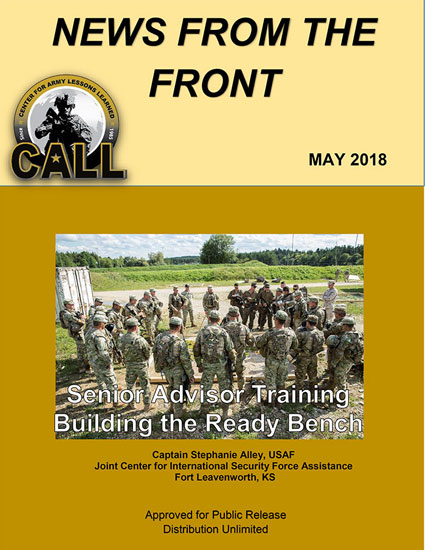 NFTF: Senior Advisor Training Building the Ready Bench
NFTF: Senior Advisor Training Building the Ready Bench
This News from the Front article discusses the purpose and outcomes of the Senior Advisor Training Working Group hosted by the Joint Center for International Security Force Assistance (JCISFA) October 16-20, 2017. The article discusses the background on the senior advisor training problem, the three topic areas the working group considered, and the working group's recommendations.
 NFTF - Commander’s Perspective CJFLCC-OIR Operations
NFTF - Commander’s Perspective CJFLCC-OIR Operations
The Center for Army Lessons Learned conducted a key leader interview (KLI) with MG Robert "Pat" White, Commanding General of the 1st Armored Division (1AD). MG White assumed responsibility of Combined Joint Force Land Component Command-Operation Inherent Resolve (CJFLCC-OIR) on 12 July 2017. Building off of the momentum and gains of its predecessors the 82nd Airborne Division, and the 1st Infantry Division - CJFLCC-OIR worked by, with, and through its partner forces to defeat the ISIS Core in Iraq. This News from the Front (NFTF) is a transcription of the KLI covering various topics ranging from the preparation to transition from a division to a combined-joint entity to working by, with, and through the Iraqi Security Force (ISF) partner force.
 NFTF - Medical Preparation and Prevention in the Horn of Africa
NFTF - Medical Preparation and Prevention in the Horn of Africa
There are numerous health risks throughout the Combined Joint Task Force-Horn of Africa (CJTF-HOA) area that are potential threats to deployed personnel. The information presented will familiarize you with the environment of the Horn of Africa (HOA) and will help you recognize your potential “enemies.” As the preponderance of military forces are in Djibouti, this news from the front (NFTF) article discusses medical preparations and preventive measure leaders and Soldiers should take when deploying to the Horn of Africa, Djibouti City and Camp Lemonnier (CLDJ).
Pages
Other Products
 News From the CTC: Questions of MGS Platoon Relationships within the SBCT
News From the CTC: Questions of MGS Platoon Relationships within the SBCT
The purpose of this article is to discuss the command and control relationship and employment of the mobile gun system (MGS) platoon within the Stryker Brigade. The observations were collected by JMRC OCTs during a unit rotational exercise.
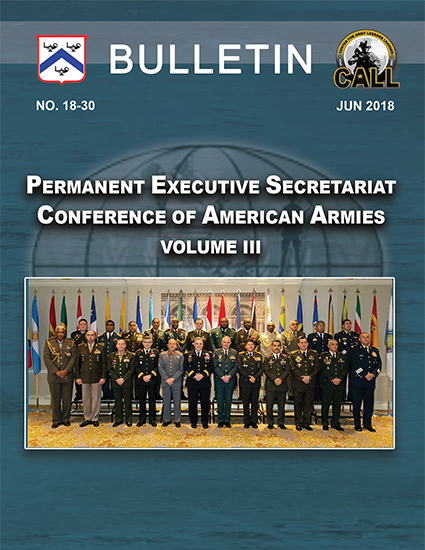 18-30 - Permanent Executive Secretariat Conference of American Armies Volume III
18-30 - Permanent Executive Secretariat Conference of American Armies Volume III
This is the third and final Center for Army Lessons Learned (CALL) bulletin covering the U.S. Army hosting of the 32nd cycle of the Conference of American Armies (CAA). This bulletin serves as a guide for planning and executing CAA events organized by the Permanent Executive Secretariat of the Conference of American Armies (PESCAA) at the culmination of a two year cycle. It provides a combination of lessons learned and best practices to facilitate planning, coordination, and execution of CAA conferences in accordance with the organization’s bylaws.
 USARCENT Intermediate Division Headquarters (IDHQ) Operation Spartan Shield 29th Infantry Division Observations Report
USARCENT Intermediate Division Headquarters (IDHQ) Operation Spartan Shield 29th Infantry Division Observations Report
This report delivers observations made during the 29th Infantry Division's deployment to the U.S. Army Central area of responsibility to serve as the Intermediate Division Headquarters (IDHQ) from the period December 2017 to July 2018. It highlights lessons and best practices used during this mission that can assist follow-on IDHQs in preparing for their deployment and allow more rapid integration into the ARCENT mission command structure once in theater.
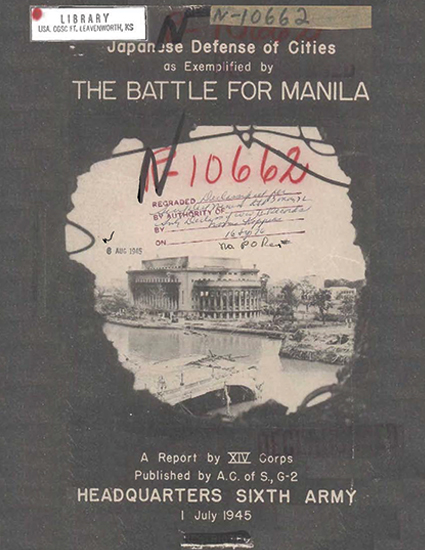 The Battle for Manila
The Battle for Manila
The following points are stressed in this report: weapons by the Japanese, obstacles encountered, the integration of weapons and obstacles in defensive organization, and tactics employed in small unit engagements by both Allied and Japanese troops. In order to make the report as comprehensive and as clear as possible, additional subjects, as listed in the index, have been included. Illustrations, sketches and pictures are in the numbered annexes.
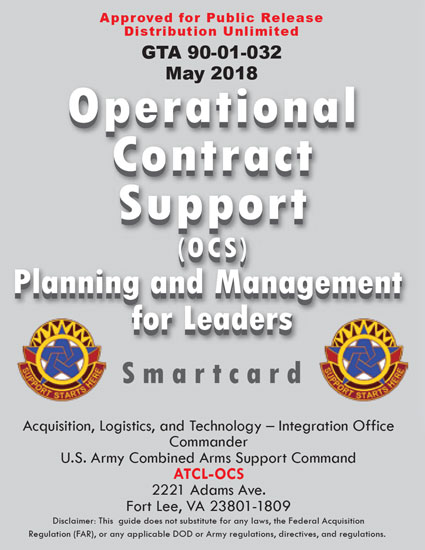 GTA 09-01-032: OCS Planning and Management for Leaders
GTA 09-01-032: OCS Planning and Management for Leaders
The Operational Contracting Support Graphic Training Aid (GTA) helps contracting officers, contracting officer's representatives, and Army units with the difficult process of contracting goods and services both stateside and while deployed. Most commonly asked questions are answered with this GTA.
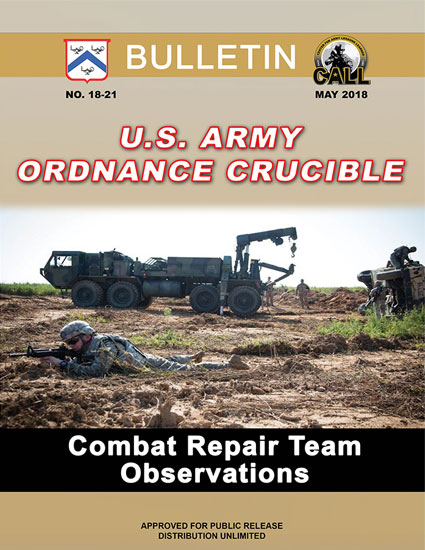 18-21 US Army Ordnance Crucible Combat Repair Team Observations Bulletin
18-21 US Army Ordnance Crucible Combat Repair Team Observations Bulletin
This bulletin provides the Army’s operating force with recommendations based on a deliberate collection of tactical and technical observations gained during the 2017 Combat Repair Team of the Year Competition as part of the U.S. Army Ordnance Crucible. The 2017 U.S. Army Ordnance Crucible consisted of three major competitions: Ammunition Transfer and Holding Point, Combat Repair Team, and Explosive Ordnance Disposal. The competitions were designed to test Soldiers’ teamwork and critical thinking skills as they applied technical solutions to real-world problems. The U.S. Army Ordnance Crucible allowed divisions to validate institutional training and their respective units’ skills.
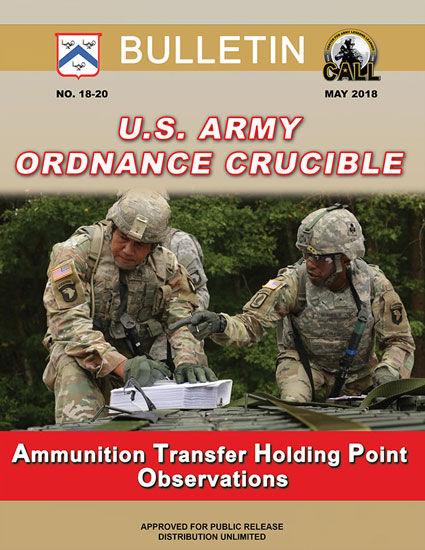 18-20: US Army Ordnance Crucible Ammunition Transfer Holding Point Observations Bulletin
18-20: US Army Ordnance Crucible Ammunition Transfer Holding Point Observations Bulletin
This bulletin provides the Army’s operating force with recommendations gained based on a deliberate collection of tactical and technical observations during the 2017 Ammunition Transfer and Holding Point (ATHP) Team of the Year competition as part of the U.S. Army Ordnance Crucible.
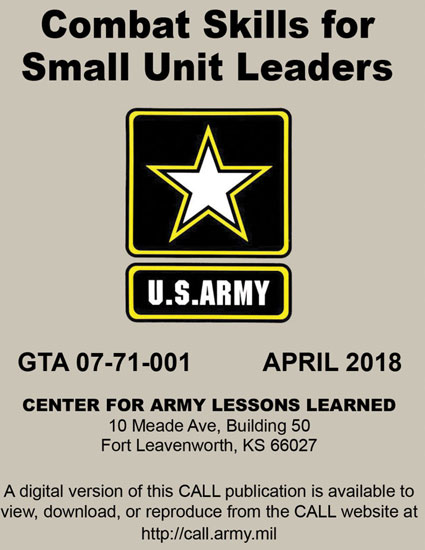 GTA 07-71-001 Combat Skills for Small Unit Leaders
GTA 07-71-001 Combat Skills for Small Unit Leaders
This GTA is a pocket-sized quick reference guide for U.S. Army Soldiers providing summarized checklists, processes, and critical data to support Soldiers and leaders conducting small unit operations. The information contained in this GTA encompasses the basic fundamentals of the Army Warrior Tasks and Battle Drills to enhance Soldier capabilities while conducting missions in training or operational environments.
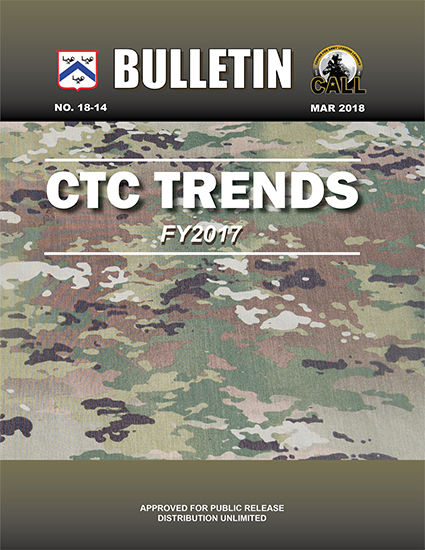 18-14 - CTC Trends FY2017 Bulletin
18-14 - CTC Trends FY2017 Bulletin
This CTC Trends Bulletin identifies trends for fiscal year 2017 across the CTCs, based on observations from observer-coach/trainers (OC/Ts) and collection and analysis teams from the Center for Army Lessons Learned (CALL), with support from various Army Centers of Excellence. A trend is defined in Army Regulation 11-33, Army Lessons Learned Program (14 JUN 2017), as "an identified issue or best practice supported by three or more observations from multiple sources within a reasonable period." CALL collects observations, best practices, and training results from OC/Ts at the CTCs; analyzes them; and compiles them annually in a publication. Organized by Army tactical tasks from the Army Universal Task List, these CTC trends reflect both positive performance (sustains) and areas that need emphasis (improves). CTC trends provide valuable information to units developing and executing training for deployment to a CTC or an operational environment. Each chapter includes recommendations for units to successfully execute identified tasks. This provides a reference for training emphasis at home station. Additionally, identifying and analyzing trends allow doctrine writers, training developers, and other Army problem solvers to receive successful techniques and identify gaps in capability for doctrine, organization, training, materiel, leadership and education, and personnel and facilities (DOTMLPF) solutions. Applying the lessons learned at the unit or the institutional level from trends that are identified enables the Army to be a continually learning organization.
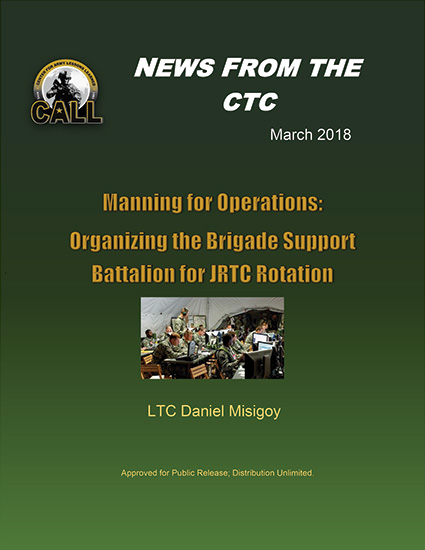 News From the CTC: Manning for Operations: Organizing the Brigade Support Battalion for JRTC Rotation
News From the CTC: Manning for Operations: Organizing the Brigade Support Battalion for JRTC Rotation
Organizing the Brigade Support Battalion for JRTC Rotation The purpose of this article is to describe how the 225th Brigade Support Battalion organized its forces to support Task Force Warrior during JRTC 17-04. The article will focus on how the unit’s organization deviated from the MTOE, and what risks were assumed and why
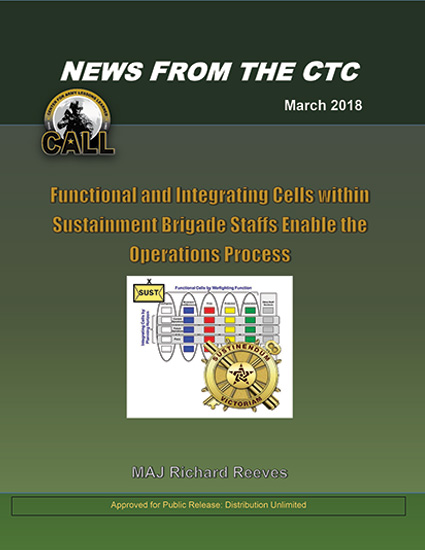 News From the CTC: Functional and Integrating Cells within Sustainment Brigade Staffs Enable the Operations Process
News From the CTC: Functional and Integrating Cells within Sustainment Brigade Staffs Enable the Operations Process
This article is primarily intended for Army sustainment officers and NCOs who are newly assigned to a sustainment brigade staff. Such individuals, having spent the majority of their careers (so far) down in companies or battalions, are often unaware of the processes and procedures they must undertake to successfully accomplish their mission.
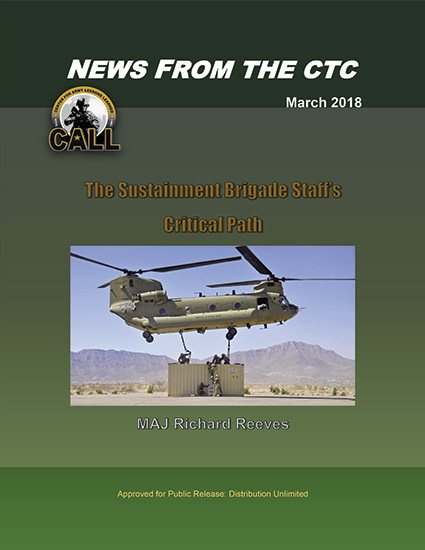 News From the CTC: The Sustainment Brigade Staff’s Critical Path
News From the CTC: The Sustainment Brigade Staff’s Critical Path
This article is primarily intended for Army sustainment officers and NCOs who are newly assigned to a sustainment brigade staff. Such individuals, having spent the majority of their careers (so far) down in companies or battalions, are often unaware of the processes and procedures they must undertake to successfully accomplish their mission.

